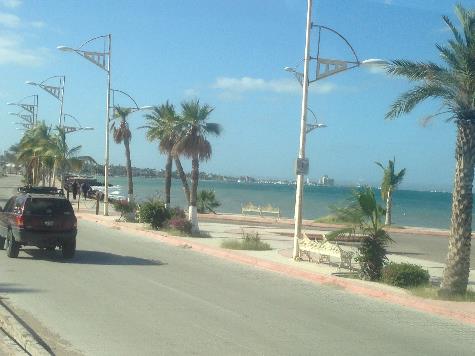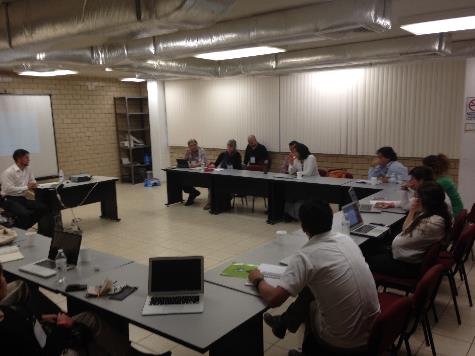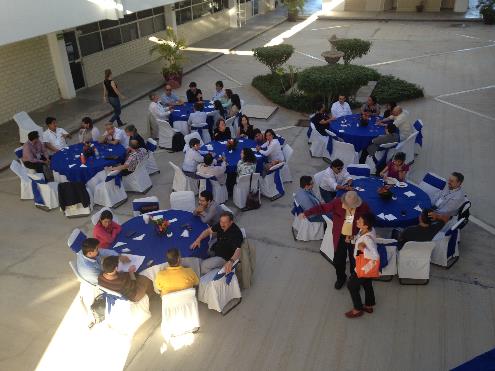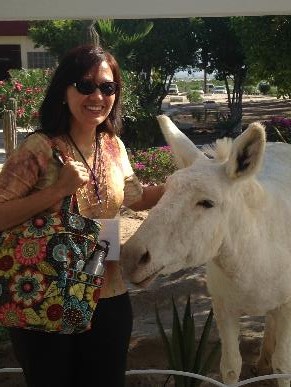
part of the peninsula overlooking the Sea of Cortez. (Google Maps)
From 17-20 November, I participated in a workshop on climate change adaptation in urban settlements in La Paz, Baja California Sur, Mexico. This workshop was organised by the Red Nacional de Investigación Multidisciplinaria en Cambio Climático (National Interdisciplinary Research Network on Climate Change) at the Universidad Autónoma de México (UNAM) (National Autonomous University of Mexico). This is the largest public university and research institution in Latin America.
After having lived in the U.S. for many years, every time I go back to my country – Mexico – it seems like going back in time. It feels surreal. I find incongruences here and there – just like in dreams. Some of them can be considered paradoxes, while others are subtler. In addition, I have mixed feeling about my country. There are many wonderful things in Mexico that I miss so much and other things that I do not. For example, on the one hand, the food is so good and fresh: tortillas without preservatives, freshly cut ripe papaya for breakfast, quesadillas with fresh pumpkin flowers or huitlacoche (a fungus that grows on corn and is considered a delicacy), to name a few. On the other hand, you cannot drink tap water because the quality is not good and you may get sick. So, if you visit Mexico, you have to buy bottled water. I definitely do not miss this.

I arrived at the Centro Interdisciplinario de Ciencias Marinas (CICIMAR), the host institution for this workshop, and this is where I spent the following three days. The taxi drove me through a wetland to reach the CICIMAR facilities, which are located right on the coast, overlooking the Sea of Cortez. The beautiful view of the blue sea could not keep my mind off the fact that this research centre, that works with marine ecosystems, was built on the most ecologically sensitive area – a wetland – therefore destroying that part of the ecosystem. Do you see the paradox? Wouldn’t people who study marine ecosystems know better than to locate the building somewhere else? It is very likely such factors were not considered in the decision-making process, which is probably why they are studying the need to consider stakeholders – scientists in particular – in the decision-making process of coupled social and ecological systems.

adaptation worked in separate and adjacent rooms.
My presentation was titled “Green infrastructure: A climate change adaptation strategy for cities in arid lands.” In this talk, I described the potential benefits of green infrastructure – or areas dominated by vegetation and pervious surfaces. Green infrastructure can be used to direct stormwater for infiltration into the aquifers, therefore increasing groundwater levels and reducing flooding risk in cities. I also presented the research project that I intend to start in the spring 2016 along with my colleague from El Colegio de Sonora, Dr. Rolando Diaz Caravantes. We will look for empirical evidence of green infrastructure in terms of reducing temperatures and flooding risk, and increasing water security in Hermosillo, Mexico. My talk was very well received by the group of about 12 scientists that composed Group #3: Climate change adaptation in urban settlements.
The other presentations in my group were fantastic! I learned so much. I heard about research on the aftermath of flooding events in Chiapas, Mexico; vulnerability assessment; research on the multiple routes of waste in Mexico City; and a future of urban mining for rare earth elements. Because some important elements are so scarce and their sources are finite, urban mining of human waste is being considered as a viable option in the near future. And talking about waste, during the coffee break I couldn’t help noticing all the waste we were producing ourselves! We used polystyrene cups for coffee, and drank bottled water without recycling the plastic bottles. Another paradox. Just like the location of CICIMAR, we were scientists discussing waste and sustainability and at the same time creating the most unsustainable waste.

the food incredible, and the conversation very interesting.
The other presentations were equally interesting. I learned about important efforts being undertaken by the Mexican government to improve transportation in cities through the design of complete streets. This means moving away from car-oriented development toward streets that integrate public transportation with biking lanes and sidewalks. This approach reduces traffic and greenhouse gas emissions from automobiles. I couldn’t feel more optimistic for the future of cities in Mexico! I also heard about significant efforts to transition towards renewable energy in California. The topic of the water-energy nexus in the US-Mexico border really caught my attention. For example, water is pumped uphill from Northern Sonora to Northern Baja California Norte. A huge amount of energy is used to transport water up the hill while none of it is captured on the way downhill. There is an opportunity here! I also heard about valuable work done in La Paz. Our host city is one of the few Mexican cities that are working towards reducing carbon emissions. I felt very proud!

At the end of the second day, my group went out to dinner to a charming local restaurant named “Las Tres Vírgenes.” I entered a vernacular Mexican house with a courtyard lit with white patio lights combined with purple lights on the vegetation. The ambiance was inviting, the conversation interesting and relaxed. We had spent the last two days getting to know each other, and by then, we knew the area of expertise of everyone at the table. The food was fantastic, and as I looked around trying to grasp the moment, I noticed that in that beautiful courtyard, there were a couple of booths. Again, is it just me, or isn’t it odd to have booth tables – like a diner restaurant – in a courtyard of a fancy Mexican restaurant? It felt slightly surreal, like I was in a painting by Chagall.

The next morning I felt like Chagall was following me. On our way to the conference room in CICIMAR, we encountered a white donkey. Where did it come from? The donkey was very amicable, allowing all of us to pet it and take pictures with her. Anyway, we walked toward our conference room as if nothing strange had happened.
On the third day we worked in teams to come up with a research agenda for climate-change adaptation and increased water security in cities, and made eager plans to collaborate in future research projects.
This trip made me feel very refreshed, like waking up after a good night’s sleep. I had met wonderful people, exchanged interesting ideas with them, ate the best food, saw beautiful sights, and experienced surreal moments here and there.
Now, back to reality.
